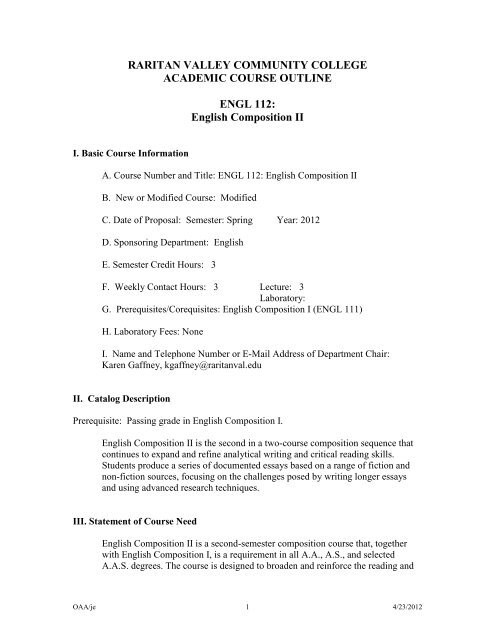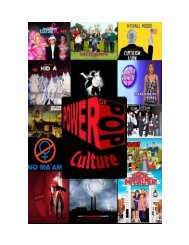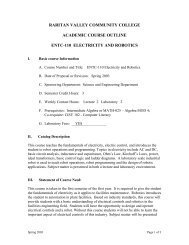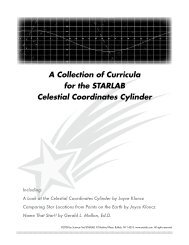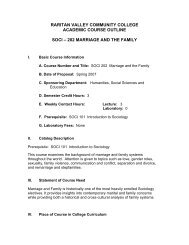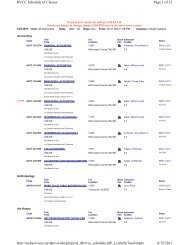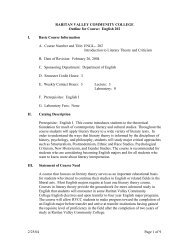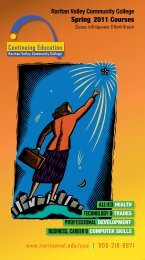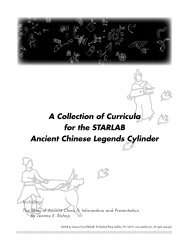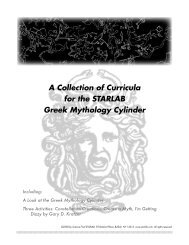ENGL 112 course outline - Raritan Valley Community College
ENGL 112 course outline - Raritan Valley Community College
ENGL 112 course outline - Raritan Valley Community College
Create successful ePaper yourself
Turn your PDF publications into a flip-book with our unique Google optimized e-Paper software.
RARITAN VALLEY COMMUNITY COLLEGEACADEMIC COURSE OUTLINE<strong>ENGL</strong> <strong>112</strong>:English Composition III. Basic Course InformationA. Course Number and Title: <strong>ENGL</strong> <strong>112</strong>: English Composition IIB. New or Modified Course: ModifiedC. Date of Proposal: Semester: Spring Year: 2012D. Sponsoring Department: EnglishE. Semester Credit Hours: 3F. Weekly Contact Hours: 3 Lecture: 3Laboratory:G. Prerequisites/Corequisites: English Composition I (<strong>ENGL</strong> 111)H. Laboratory Fees: NoneI. Name and Telephone Number or E-Mail Address of Department Chair:Karen Gaffney, kgaffney@raritanval.eduII. Catalog DescriptionPrerequisite: Passing grade in English Composition I.English Composition II is the second in a two-<strong>course</strong> composition sequence thatcontinues to expand and refine analytical writing and critical reading skills.Students produce a series of documented essays based on a range of fiction andnon-fiction sources, focusing on the challenges posed by writing longer essaysand using advanced research techniques.III. Statement of Course NeedEnglish Composition II is a second-semester composition <strong>course</strong> that, togetherwith English Composition I, is a requirement in all A.A., A.S., and selectedA.A.S. degrees. The <strong>course</strong> is designed to broaden and reinforce the reading andOAA/je 1 4/23/2012
writing skills learned in English Composition I, with added emphasis on doingresearch and writing from sources. Students continue to strengthen these essentialskills so that they will be able to apply them to <strong>course</strong>work in other disciplines.This <strong>course</strong> typically transfers as an English core requirement.IV. Place of Course in <strong>College</strong> CurriculumA. Free Elective (This applies automatically to all credit <strong>course</strong>s in the <strong>College</strong>).B. This <strong>course</strong> serves as a General Education <strong>course</strong> in English Composition.C. This <strong>course</strong> meets a program requirement for all A.A. and A.S. degrees, andfor selected A.A.S. degrees.D. Course transferability; for New Jersey schools go to the NJ Transfer website,www.njtransfer.org. For all other colleges and universities go their individualwebsites.V. Outline of Course ContentA. ReadingCritical reading of fiction and non-fiction texts with an emphasis on analysisand synthesis of themes drawn from multiple sources.B. Writing1. Continued emphasis on writing as a recursive process that includes freewriting, drafting, peer review, editing, and revising in developing polishedessays2. Technical Competencea. Skills required to organize coherent longer essays from multiple sourcesb. Finer points of usage, grammar and mechanicsC. Information Literacy1. Required advanced session of library instruction or online equivalent2. Focus on using RVCC Library’s databases to locate sources, includingscholarly sources3. Focus on evaluating relevance of sources4. Review of MLA documentation procedures and the ethics of integratingand documenting source materialsVI. Educational Goals and Learning OutcomesA. Educational GoalsStudents will:1. write essays that reflect critical thought, demonstrate fluency, coherence,organization, and control of grammar and mechanics.(GE-NJ 1)2. write essays that analyze fiction and non-fiction texts. (GE-NJ 1)OAA/je 2 4/23/2012
3. write essays that synthesize ideas across a variety of texts.(GE-NJ 1)4. conduct research and employ sources using responsible and ethicaldocumentation procedures.(GE-NJ IL)5. demonstrate analytical thinking and engagement with texts in classdiscussion.(GE-NJ 1)B. Learning OutcomesWritingStudents will be able to1. write essays that identify thematic connections between and among avariety of fiction and non-fiction texts. (Goal 2 and 3)2. write comparative and analytical essays that support a central point. (Goal 1,2, and 3)3. write clearly, grammatically and fluently with focus and continuity instandard American English in essays written in class as well as out of class.(Goal 1)ReadingStudents will be able to4. explicate readings in writing as well as during class. (Goal 2, 3, and 5)Information LiteracyStudents will be able to5. access, evaluate, and use information effectively and ethically at anadvanced level. (Goal 4)6. write essays that demonstrate facility with research techniques and theconventions of citation. (Goal 4)VII. Modes of Teaching and LearningGiven the goals and outcomes described above, LIST the primary formats, modes,and methods for teaching and learning that may be used in the <strong>course</strong>:A. DiscussionB. Mini-lectureC. Small group workD. Guest speakersE. Collaborative student projectsF. FilmG. Computer-assisted instructionOAA/je 3 4/23/2012
VIII. Papers, Examinations, and other Assessment InstrumentsGiven the outcomes described above, LIST which of the following assessmentmethods may be used:A. Formal essays written out of classB. Research projects and papersC. Essays and examinations written in classD. QuizzesE. JournalsF. PortfoliosIX. Grade DeterminantsA. 25 pages of graded writingB. 4-5 out-of-class essays of 4-8 pagesC. Continued emphasis on writing as a process that includes free writing,drafting, peer review, editing and revising in order to develop polished essays.D. At least 3 graded in-class essays that are text based, including a final examE. Requirement that at least 80% of the student’s final grade be derived fromgraded essaysF. Requirement that students write essays that engage multiple textsG. Requirement that students write more than one essay based on researchX. Texts and MaterialsA. Textbook: anthology of readings such as Literature for Composition, shortercurrent edition, eds. Richard Abcarian and Marvin KlotzB. FilmC. Audio sourcesD. Web sourcesE. Other computer-based sources(Please Note: The <strong>course</strong> <strong>outline</strong> is intended only as a guide to <strong>course</strong> content andresources. Do not purchase textbooks based on this <strong>outline</strong>. The RVCC Bookstore is thesole resource for the most up-to-date information about textbooks.)XI. Resources: The following teaching tools support English Composition II:A. Library instruction room at least once a termB. Classrooms with CATT set-up preferredC. Computer lab preferredD. Service Learning support where applicableOAA/je 4 4/23/2012


